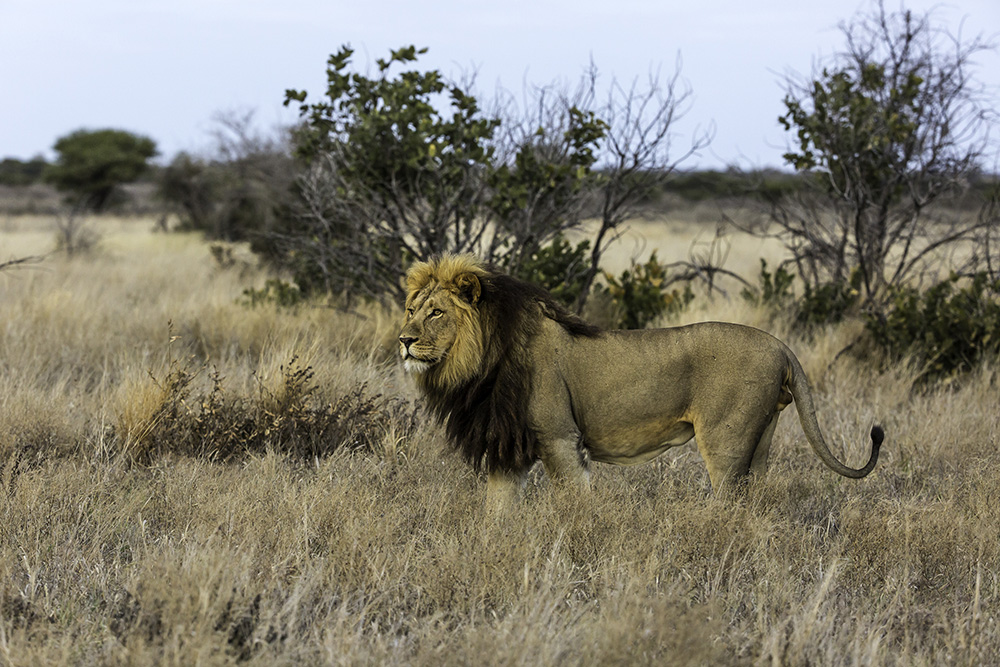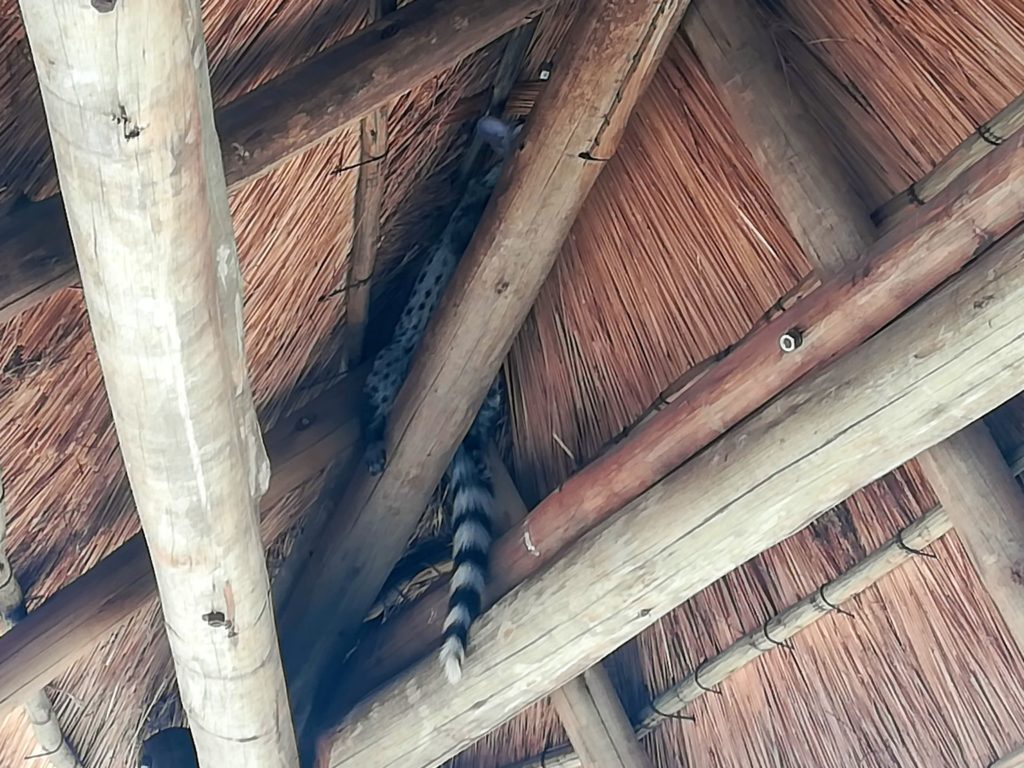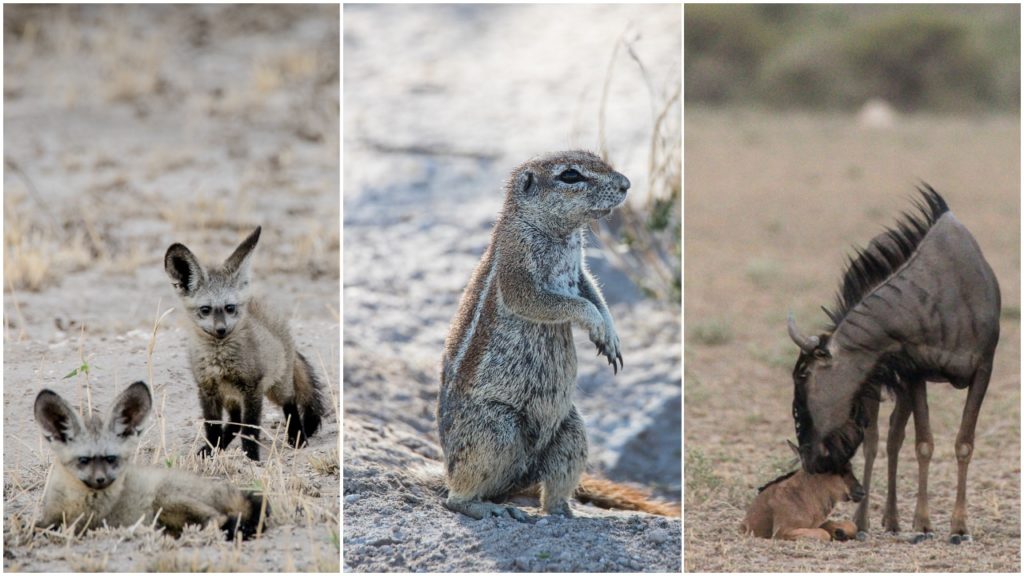There is a Genet in my roof!
It was a scorching day in November, typical weather for this time of year. I had put my bags down, grabbed a cold bottle of water and headed straight for my deck chair to take in the sweeping views of the Central Kalahari Desert.
The Kalahari was nothing like I thought it would be, except for the heat. That was exactly how I anticipated but one can never fully prepare for it.

Movement between my tent and the main area was more of a hop, skip and a jump! I had opted to wear open sandals, and these are great on a flat surface, but they sure made for clumsy dance in the red-hot sand.
Standing on the deck outside my tent, I took in the incredible views of the Desert before me. Those who have been to Botswana, know how flat the land is, one can literally see for days! Yet here in the Kalahari; equally as flat, an ancient sand dune exists, and up on this ridge is where Tau Pan Camp is located.
This was to be my temporary home for the next 24 hours and every image I had previously held in my imagination was wiped out by the beauty unfolding before my eyes. The Kalahari is not barren and sandy, as one would expect in most deserts. Even when it is dry enough to ‘qualify’ as a desert, it is not strictly speaking a desert because the ground cover is too dense.
‘Tau’ is the Setswana word for lion and the Kalahari is famed for the impressive compliment of black-maned lions, the very same that frequent the permanent water hole located in front of camp. What I thought was going to be a quiet dreamy night under the stars, turned out to be rather a noisy and interrupted sleep with a choir from the wild; well more like a symphony of roars from one pride to the next that bellowed throughout the night. It was an impressive sound, one that never rings tired with me.

I sat down in my deck chair, dusted the sand from my feet and lifted them up to the small table in front of me. Head back, eyes closed and just about ready to take in my afternoon siesta when something inside me insisted that I look up.
As I opened my eyes, I caught a glimpse of a bushy striped tail hanging from a rafter; and there it was…a beautiful little genet, sleeping peacefully in the shade of the thatch. We both had the same great idea for that hot afternoon in Africa; quiet uninterrupted blissful sleep.

For those wanting to visit the Kalahari, do it on your next planned safari in Botswana. It’s wild and mysterious beauty almost never disappoints!
Interesting facts about the Central Kalahari:
With 52,000 km2 the Central Kalahari Game Reserve is the world‘s second largest protected area and one of the most remote and pristine areas in Africa.
The Central Kalahari Game Reserve is mostly famous for its ancient fossil river beds, which form valleys through the bush of which Deception Valley is the most famous. A highly recommendable read is “The Cry of the Kalahari” by Delia and Mark Owens.
Specialized desert species are found in the Central Kalahari Game Reserve with gemsbok (oryx) and springbok often seen; the famous black-maned Kalahari lions and of course bat-eared foxes. And if you are very lucky, the brown hyena.
Although the Central Kalahari is an all year round destination, an especially magnificent time is during and after the summer rains when the colors of the Kalahari explode and grey turns into fifty shades of green. The rainy starts in mid November and ends in March.

Information on Kwando Tau Pan:
Tau Pan is one of two lodges located within the Central Kalahari Game Reserve, the other being Kalahari Plains.
Activities offered at Tau Pan include game drives, day trips to Deception Valley, Sunday, Piper and Passarge Pans, star gazing and nature walks with Bushman trackers.
Accommodation consists of 9 environment adapted en-suite rooms including 1 family room and a sleepout deck (an absolute treat for the more adventurous!).
100% solar operated
All-inclusive rates
Guide and tracker team
The truth about “Green Season” in Botswana
With our first rain of the season last night, the residents of Maun are breathing a sigh of relief. It is a welcome reprieve from the October heat. With all the industry talk of “Green Season” and the countless specials on offer, I thought I would shed some light on the subject for those wanting to travel to Botswana at this special time of year.
The green season in Botswana (Dec—Mar) is becoming increasingly popular as many operators offer significantly reduced rates paired with clever marketing strategies. However, you need to know the difference in the product during these months and be honest with your prospective customers.
Both wet and dry spells occur throughout the season. Typically short, spectacular afternoon showers offer a welcome relief from the heat of the day and make for great photographic opportunities. However, periods of heavy rain, low cloud cover and drizzle can occur.
Large concentrations of wildlife surrounding the permanent waterways during the dry season disperse to seek new grazing and are sustained by the seasonal pans now filled with rain water. Lower concentrations of wildlife are compensated for with lower visitor numbers offering added exclusivity. With the arrival of the rain comes new life as birthing season begins for many species. Predators take advantage seeking out the vulnerable young as easy prey creating spectacular wildlife interaction. Heronries and other nesting colonies are very active at this time of year and it is the peak breeding time for many of the colorful migrant birds.
The normally arid landscape of the Kalahari is transformed into a thriving paradise teaming with herds of springbok and gemsbok attracted by the short, sweet grasses and the water filled pans. Nxai Pan becomes home to thousands of Zebra resulting in excellent predator interaction with the resident lion prides.
The scenery is refreshingly lush and vibrant as the dust is washed away and trees and flowers burst into life. The retreat of the flood means that more varied habitats are accessible to explore on game drives. Lower water levels in the delta can limit water activities dependent on seasonal flood levels. Walking is limited for safety reasons due to the cover provided by the long grass and lush vegetation.
The green season rates offer excellent value for money, providing a great opportunity to visitors that could otherwise not afford Botswana, or returning visitors that would like to see a different side.


